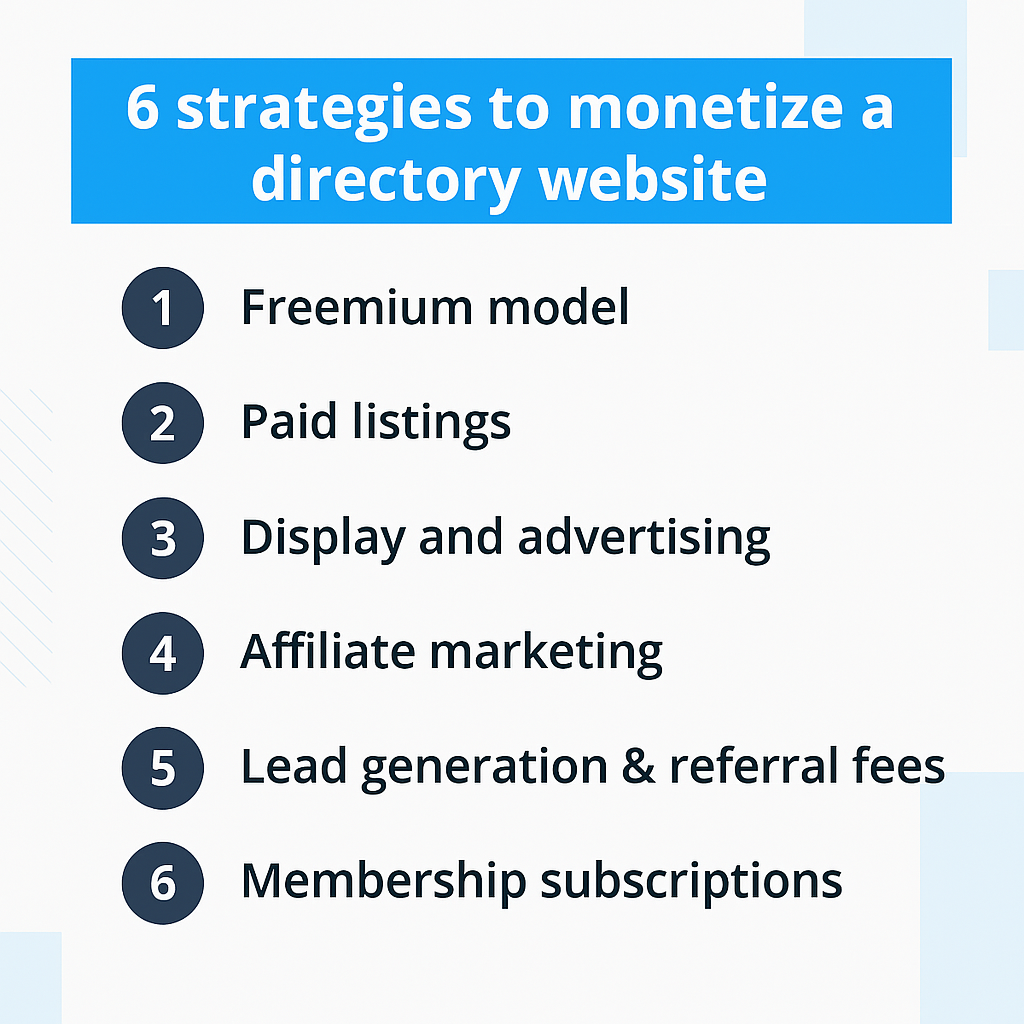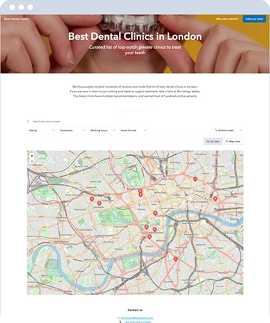How to monetize a directory website: 6 proven strategies + expert tips
Monetizing a directory website isn’t just about putting up listings and waiting for the money to roll in—it requires thoughtful planning and choosing the right revenue models for your niche, audience, and growth stage.
At its core, a directory website can generate income from three main sources:
- Businesses that pay to be listed or promoted
- Visitors who subscribe, purchase premium content, or generate leads
- Advertising partners who want exposure to your audience
The right mix depends on your market, traffic volume, and the value your directory brings. In this guide, we’ll walk through the most effective monetization strategies—from freemium models and paid listings to affiliate marketing and lead generation.

1. Freemium Model
If you want to attract businesses to your directory while still making money, the freemium model is a great way to do it. The idea is simple: offer basic listings for free and charge for extra features. This way, you get more businesses on your site, and many will eventually upgrade for better visibility.
With a freemium approach, businesses can create free profiles with just the basics—like their name, contact details, and a short description. But if they want more exposure, they can pay for premium perks. These might include things like featured placements, the ability to add more photos or videos, detailed analytics, or even lead capture tools.
Offering free listings lowers the barrier to entry, making it easy for businesses to get started. Once they see the value your directory provides—whether it’s generating traffic or bringing in customers—they'll be more likely to upgrade to a paid plan.
What works best?
- Highlight the value of upgrades – Make it clear why businesses should pay for premium features. Show real examples of how paid listings bring better results.
- Offer time-limited trials or discounts – A free trial of premium features can help businesses experience the benefits before committing.
- Use social proof – Share testimonials from businesses that have seen success using premium listings.
A freemium model works well when you provide real value with your free option while making the paid features too good to ignore. Keep refining your offerings based on what your users need, and you’ll create a steady income stream while growing your directory.
2. Paid listings
One of the most straightforward ways to monetize a directory website is by charging businesses to add their listings. If your directory focuses on a niche market with high demand, businesses will be willing to pay for better visibility and access to potential customers. The key is to offer clear value—businesses need to see that listing on your site is worth the investment.
Instead of a one-size-fits-all pricing model, offering multiple pricing tiers works best. A basic paid listing might include a company name, contact details, and a short description. Higher-tier plans could unlock extra features like additional images, videos, priority placement in search results, or even advanced analytics. The more options you provide, the more businesses can find a plan that fits their needs and budget.
What works best?
- Set competitive but profitable pricing – Research similar directories to see what they charge and what features they offer. Then, position your pricing to be attractive while still making a solid profit.
- Bundle services – Instead of just selling listings, combine them with extras like featured blog posts, banner ads, or social media promotion. This makes your directory more valuable to businesses.
- Show performance metrics – Offer analytics that show businesses how many views, clicks, and leads their listings generate. If they see clear results, they’ll be more likely to renew and even upgrade.
By structuring your paid listings in a way that makes businesses feel like they’re getting real value, you turn your directory website into a powerful revenue-generating platform. The more businesses see success from their listings, the more they’ll invest in premium options.

3. Display advertising
Selling ad space on your directory website is one of the most passive ways to generate income. As long as you’re getting traffic, you can earn—whether through ad networks like Google AdSense or by selling directly to businesses in your niche. Display advertising doesn’t require constant hands-on management, which makes it a popular monetization option.
To get started, you’ll want to decide where the ads will go. Think sidebars, top banners, footer placements, or even within the listing pages themselves. It’s all about balance—you want the ads to be seen without hurting the overall user experience. Partnering with an ad network is the quickest route, but if your directory serves a specific niche, direct ad sales can bring in significantly more revenue.
What works best?
- Start with smart placement – Place ads in high-traffic areas of your site, but avoid overloading your pages. Too many ads can drive users away.
- Try both approaches – Use Google AdSense for filler ads, and reach out to businesses directly for premium ad spots, like homepage banners or category-specific placements.
- Track performance – Keep an eye on impressions, click-through rates, and earnings. Tools like Google Analytics or heatmaps can help you optimize ad positions.
The key to successful display advertising is subtlety. When done right, it blends naturally into your directory’s layout, generates ongoing revenue, and doesn’t interfere with your users’ browsing experience. And as your site grows, your ad space becomes more valuable—especially to niche businesses looking for targeted exposure.
4. Affiliate marketing
Affiliate marketing is a low-effort, high-potential way to monetize your directory website—especially if you already have a steady stream of visitors who trust your content. Instead of selling products or services directly, you earn a commission every time someone clicks your affiliate link and makes a purchase.
To make it work, the key is relevance. Your affiliate partnerships should align closely with your directory’s niche. For example, if you run a local business directory, you could promote tools for small business owners, appointment booking software, or even relevant SaaS platforms. And the links don’t have to be pushy—you can weave them into your listings, blog posts, or even comparison tables without breaking the user experience.
How to get started
- Find affiliate programs – Start with major affiliate networks like ShareASale, PartnerStack, or Impact. Look for programs that are a natural fit for your audience.
- Place links strategically – Add affiliate links inside business listings (if relevant), or within supporting content like blog posts, guides, or category pages.
- Keep it transparent – Always disclose your affiliate relationships. A simple “this post may contain affiliate links” goes a long way in building trust.
Affiliate marketing can bring in recurring passive income while enhancing the usefulness of your directory. If you're recommending tools or services your users genuinely need, everybody wins—you provide value, the businesses get exposure, and you earn a commission. Just remember to track what’s working and tweak as needed. A few well-performing links can outperform dozens of poorly placed ones.
5. Lead generation & referral fees
If your directory connects people with services—think consultants, home repair pros, or B2B vendors—you’re sitting on a goldmine of leads. With the right setup, you can charge businesses for the customer inquiries your directory generates. This model is especially powerful in niche markets where leads are valuable and hard to find.
Here’s how it works: a visitor finds a business listing on your site, fills out a contact form or quote request, and you pass that lead along to the business—either for a flat fee, per lead, or as part of a monthly subscription. Some directories even sell exclusive leads at a premium, meaning only one business receives the contact info, increasing its value.
How to get started
- Add lead capture forms – Use custom forms or simple CTA buttons on your listings or category pages to collect user interest.
- Distribute leads smartly – Automatically forward leads to listed businesses, or create a system where businesses pay to unlock contact details.
- Set up your pricing – You can charge per lead, per month, or offer packages with guaranteed volumes.
When done right, lead generation becomes a win-win: users get fast responses, and businesses gain warm leads. To build long-term trust, focus on quality over quantity—filter out spam, verify submissions, and follow up with partners to see how your leads convert. The more confidence they have in your directory’s lead quality, the more they’ll be willing to pay.
6. Membership subscriptions
If you’re looking for recurring revenue, membership subscriptions are one of the most powerful models you can implement on a directory website. Instead of relying on one-time fees, you offer exclusive perks to members—think enhanced listings, access to premium content, tools, or a community of like-minded businesses or users.
This model works best when you’ve built a reputation as a go-to resource in your niche. Whether you're curating expert content, offering promotional opportunities, or enabling networking between members, subscriptions can add real value beyond a basic listing.
How to get started
- Define the perks – Decide what members get: featured placements, access to hidden listings, premium reports, or early access to leads.
- Create tiers – Offer multiple membership levels with increasing benefits so you can cater to different budgets and needs.
- Build a sense of belonging – Add a community element—private forums, Slack groups, or monthly webinars—to make your membership more than just a feature list.
To keep churn low, you need to deliver ongoing value. That could mean fresh content, new perks, or seasonal promotions. Don’t forget to ask your members what they actually want—it’s often easier (and cheaper) to keep an existing subscriber than to find a new one.
How to get traffic to a directory website
Monetization strategies only work when people are actually visiting your site. That’s why one of the most important parts of building a successful directory website is attracting consistent, high-quality traffic. This is especially true if you're using models like paid listings, display advertising, or affiliate marketing—because traffic translates directly into visibility and revenue.
Here’s a proven checklist to help you drive more traffic to your directory website:
- Target long-tail keywords: Focus on specific search terms relevant to your niche — for example, “best wedding photographers in Austin” instead of just “photographers”. These keywords have lower competition and attract more qualified leads.
- Create local landing pages: If your directory covers multiple cities or regions, build separate landing pages for each area. Local SEO is one of the most powerful drivers of organic traffic for directory websites.
- Encourage user-generated content: Let businesses and users add reviews, photos, or updates. Not only does this keep your content fresh for search engines, but it also boosts engagement.
- Leverage schema markup: Use structured data to help search engines better understand your content. For example, localBusiness and organization schema can improve how your listings appear in search results.
Publish helpful content regularly: Blog posts like “Top 10 [industry] businesses in [location]” or “How to choose the right [service]” work well to attract new visitors and establish topical authority in your niche. - Build backlinks smartly: Reach out to listed businesses and encourage them to link to their profile on your site. Also collaborate with industry blogs, news outlets, and influencers for quality backlinks.
- Run targeted ad campaigns: If you’re just starting out, consider using Google Ads or Facebook Ads to drive niche traffic to your most valuable landing pages.
- Don’t forget about social media: Start social media pages for your project, featuring your favourite listings, blog posts or opinions on the industry. Genuine unique content and honest opinions are what work best on social media.
Bonus insight: Don’t rely on a single traffic channel. The most sustainable directory websites get traffic from a mix of organic search, social, email, direct, and referrals. Learn more on getting more eyes on your webpage from our guide: How to boost traffic on your website.
How to create a directory website with SpreadSimple
If you’re looking for a fast and easy way to create a directory website, SpreadSimple is one of the best no-code tools available. It lets you build a clean, responsive, and user-friendly directory from your Google Sheets data—no coding or design skills needed.
If you already have a structured Google Sheet with business data, categories, or listings, you’re halfway there. SpreadSimple can instantly turn that sheet into a live website.
SpreadSimple comes with a pre-built directory template that includes filters, search, image previews, and CTAs—perfect for listings, portfolios, marketplaces, or affiliate pages.

To this template, you can add paid listing features, badges, and even connect payment options—all without writing a single line of code.
SpreadSimple supports custom domains, analytics, and integrations with tools like Zapier and Mailchimp, making it a scalable solution even for growing directories.
This is especially useful if you're just getting started and want to quickly validate your idea without spending months on development.
Conclusion: turning your directory website into a revenue machine
Monetizing a directory website is absolutely doable with the right strategy and execution. As this article showed, there are many ways to generate income—from paid listings and affiliate marketing to display ads and lead generation.
Here’s a quick round-up of what matters most:
- Use a freemium or paid listing model to monetize directly from businesses.
- Add affiliate links, display ads, and lead capture forms to turn traffic into income.
- Build a membership subscription model to create recurring revenue.
- Focus on getting targeted traffic—SEO, local pages, backlinks, and content marketing are key.
- Use a smart tool like SpreadSimple to launch your directory website in minutes using a Google Sheet.
The best part? You don’t need to be a developer or spend months building. With a structured approach and the right tools, your directory website can start making money much sooner than you think.



